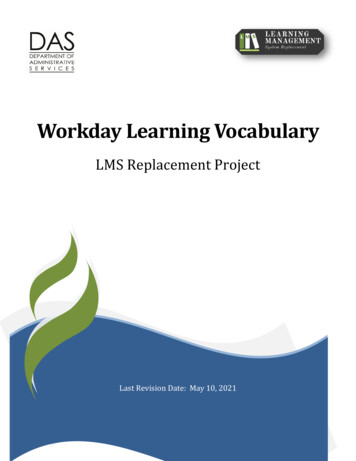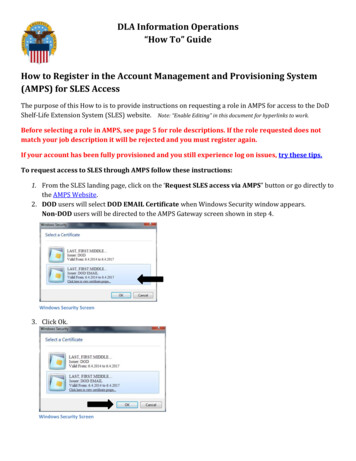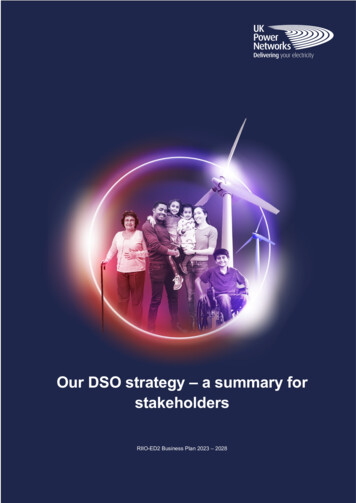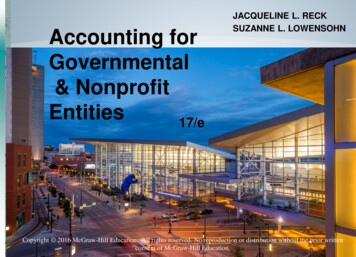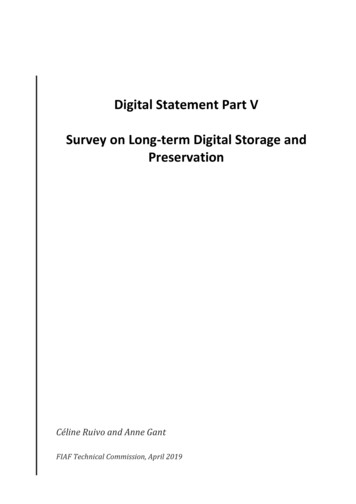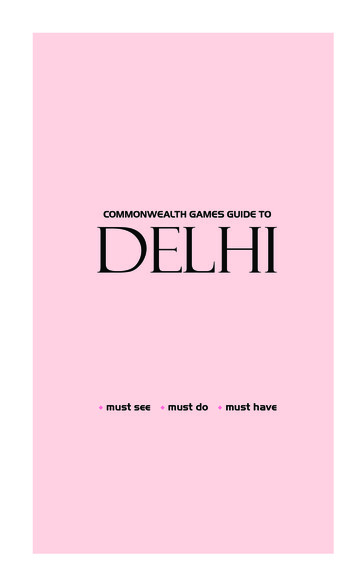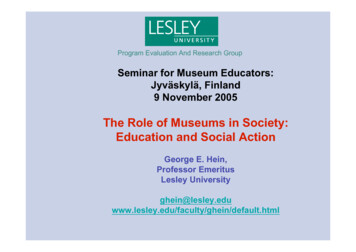
Transcription
Program Evaluation And Research GroupSeminar for Museum Educators:Jyväskylä, Finland9 November 2005The Role of Museums in Society:Education and Social ActionGeorge E. Hein,Professor EmeritusLesley hein/default.html
Are museums educational institutions?What is the appropriate education theory formuseums?Does education include a social role?My thanks Ms. Outi Nummi and the Finnish Museums Association for theinvitation to speak at this seminar and to the Public Affairs Office, U. S.Embassy in Helsinki for their support that made this trip possible.
Are museums educational institutions?Yes, Museum EducationWhat is the appropriate education theory formuseums?Constructivism (Progressive Education)Does education include a social role?Yes, it is an essential component ofeducation.
1. Types of Museums:Art, history (and historic houses) technology,science, aquaria, zoos, natural history, sciencecenters, outdoor, farm, children’s, maritime,eco-museums, specialized collections, music,popular culture, nature centers, historic sites,nature centers, etc.
Statistics:Number of museumsEurope, more than 15,000Finland: 163 museums responsible for a total of 321museum sites and locationsVisitation: Up to 50% of population annually in some countries(4.8 million visits in Finland, 2004) In USA: 16,000 museums,More visits to museums annually thanto professional sportsMuseums are a major expression of culturalIdentity In every society:
2. Changing Definition of Museums1946: The word "museums" includes all collectionsopen to the public, of artistic, technical, scientific,historical or archaeological material, including zoosand botanical gardens, but excluding libraries, exceptin so far as they maintain permanent exhibition rooms.(International Council of Museums, ICOM).2001: A museum is a non-profit making, permanent institutionin the service of society and of its development, and open tothe public, which acquires, conserves, researches,communicates and exhibits, for purposes of study, educationand enjoyment, material evidence of people and theirenvironment. (.) (ICOM)(Note: A similar shift in definition exists in AAMdocuments, 1969—2002.)
Period Pieces are shortplays with two or morecharacters designed toexamine historicalissues and universalthemes. Lasting 15minutes or longer, thesescenes are presented inthe galleries and amongthe exhibits.Kentucky riodPieces.htmMuseum Theatre
A museum is only alive when it is openand visitors are present.Everything that concerns visitors is thefocus of museum education, — and allmuseum functions impact the visitorexperience!
3. The Scope of Museum EducationWetterlund, K. & Sayre, S. 2003 Art Museum EducationPrograms Survey. Available at: http://www.museum-ed.org/
Museum Educational Work is very broad: Organize and carry out programs for exhibition visitors Programs outside visiting hours or in special settings Education methods include: dance, theatre, music,movement, etc. Develop educational materials, resources Outreach activities to classrooms, community centers, etc. Participate in other museum activities: exhibition design,accessibility, planning Carry out research on visitors or for program development Initiate external Partnerships Web site and on-line related workCondensed from: Wetterlund, K. & Sayre, S.,2003 Art Museum Education Programs Survey.Available at: http://www.museum-ed.org/
5. HistoryMuseums were an early form ofpublic education intended toenlighten (improve?) the generalpopulation.The creation of the Public Museum wasan expression of the eighteenth-centuryspirit of enlightenment which generatedenthusiasm for equality of opportunity inlearning. . . In practice, the traditions ofthe former private collections werecarried on in the public museums,notwithstanding the contrariety ofpurpose and of circumstances.Wittlin, A. S. (1949) The Museum, ItsHistory and Its Tasks in Education,London: Routledge and Keagan Paul.The Victoria and Albert Museum, London
Royal collections were opened tothe public either by revolution orvoluntarily —but still illustratedimperial acquisitions and values.Musée du Louvre“International” collections exist primarilyin (formerly) imperialist countries.
6. How can museums be classified?AestheticEducationalSocialBut all these are educational!Zeller, T. (1989) The Historical and PhilosophicalFoundations of Art Museum Education in America” inBerry, N. and, Mayer S., (eds.) Museum EducationHistory, Theory, and Practice, Reston, VA: The NationalArt Education Association.
The Educational Museum“An efficient museum . . . may bedescribed as a collection ofinstructive labels, each illustratedby a well selected specimen.”Smithsonian Institution ArchivesGeorge Brown Goode(1851 - 1896)“Ichthyologist, geneaologist, historian,curator and museum administrator . . .He proudly called himself a naturalist,publishing mostly on fishes, but alsoworking on snakes and other animals.”Kohlstead, S. G. (1991) The Origins of Natural Sciencein America,, DC: Washington Smithsonian Press. p. 5
I should not organize the museum primarily for the useof the people in their larval or school-going stage ofexistence. The public school teacher, with theillustrated textbook, diagrams, and other appliances,has in these days a professional outfit which is usuallyquite sufficient to enable him to teach his pupils.School days last, at the most, only from four to fifteenyears, and they end with the majority of mankind,before the minds have reached the stage of growthfavorable for the reception and assimilation of the bestand most useful thought.G.B. Goode, “Museum History and Museums of History,”in Kohlstedt, S. (1991) The Origins of Natural Sciencein America, Washington: Smithsonian Press, p. 307.
The Aesthetic Museum“A museum of art is primarily aninstitution of culture and onlysecondarily a seat of learning”Johns Hopkins University ArchivesBenjamin Ives Gilman(1852-1933)Graduate training in logic and Mathematics(Johns Hopkins), Philosophy (Berlin andHarvard) Psychology. Positions at the Museumof Fine Arts (Boston) included Curator,Secretary of the Trustees, Assistant director,Temporary Director, etc.Unpublished curriculum vitae (n. d.)Museum of Fine Arts Archives.
“A museum of science,” heobserved’ “is in essence aschool a museum of art inessence a temple.” . . . for whileobjects in other types ofmuseums are “adapted toinstruct,” those in art museumsare “adapted to impress.”Boston Museum of Fine Arts then (above)and now (below)But, Gilman first proposed, museuminstructors (he called them “docents”),developed extensive informativelabels, more accessible ways ofexhibiting works of art and welcomedworking-class visitors.
Examples of selected label texts developed by GilmanThis portrait in baked clay from the first centurybefore Christ represents a human who may verypossibly have spoken with Caesar. A Romanbusiness man with the alert mind, decidedcharacter and fondness for notice here expressedsurely bore his part in the momentous times ofCaesar’s death, Mark Antony’s defeat and thecrowning of Augustus Emperor.
What is the point of this story?a) Even the anti-education position of the museumhas a strong educational stress since themuseum by its nature is an educationalinstitution.b) The attempt to classify some museums aseducational and others as not (or to classifymuseum directors in this way) is not realistic.Museum directors must not only know the subject, but mustalso know pedagogy-how to teach people who knownothing: "They may be prodigies of learning and yet unfit fortheir posts.”Forbes, E. (1853) “The Educational Uses ofMuseums,” quoted in Greenwood, T., (1893) "ThePlace of Museums in Education," Science, xxii, 246
Newark Public Library PhotoThe Social Mission of MuseumsJohn Cotton Dana (1856-1929)“For Dana, the true work of the museum as aservice institution, was in enriching the quality ofpeople’s lives.”S. Weil, introduction to W. Peniston, (ed.) (1999) The NewMuseum: Selected Writings of John Cotton Dana,Washington: American Association of Museums
John Cotton Dana’s Social Aims: Provide access to all—reach out (U. S. public library model) Demonstrate good (inexpensive) taste (5 and 10 cent gallery) Provide educational opportunities Celebrate local culture—Newark and U. S. arts and crafts Preserve immigrant cultures
Newark Museum, used with permissionLouise Connolly 1862-1927Educator, civic leader, supporter of women’s right to vote.
Elaine Gurian’s Museum Classification :Object-Centered MuseumsNarrative MuseumsClient-Centered MuseumsCommunity-Centered MuseumsNational (and Government) MuseumsGurian, E. (2002) “Choosing Among theOptions: An Opinion About MuseumDefinitions,” Curator, 45[2] 75-88Note: All categories are educational!
Are museums educational institutions?Yes, Museum EducationWhat is the appropriate education theory formuseums?Does education include a social role?
If museums are educational, we need to consider:a) What is the role of museum educators?b) What should be their educational theory andpractice?Educational theory consists of two components A theory of learning (How do people learn?) An epistemology (What is knowledge?)Educational practice requires a pedagogy thatmatches the proposed theory Constructivism/Progressive Education
Theories of LearningPassive andincremental,knowledgeadded bit bybitActivelearnerconstructsknowledge
Theories of KnowledgeKnowledgeexistsindependent ofknowerKnowledgeconstructedindividually andsocially
An example of theinevitability of personalmeaning making:What do students do on aformal field trip?Meg Black Research study: systematic datacollection and analysis: interviews, writtenassignment, drawing.M. Black and G.E. Hein “You're Taking Us Where? Reaction and Response to a Guided Art MuseumField Trip,” in M. Xanthoudaki, L. Tickle & V. Sekules (eds.) Researching Visual Arts Education inMuseums and Galleries, Dordrecht: Kluwer Publishers, 2003.
Favorite objects from a highlystructured art museum tour:The group of 15 university students stopped onlyat 14 objects depicted on a museum map.Favorite object(s):On tourNot on tourBoth573
Traditional LectureAnd smHein, G. E., (1998) Learning in the Museum, London: ult.html
“ProgressiveEducation”Hein, G. E., (1998) Learning in the Museum, London: ult.html
What kind of education takes place in museums?It is primarily Progressive education, “modern” movement ineducation developed in early 20th century. Object-based Active learner Learning through inquiry and problem-solving.The contemporary term for Progressive Education isConstructivism, a combination of active learning (LearningTheory) and personal meaning making (Epistemology.)
Arguments for deciding on the appropriate museumeducation theory or, Why constructivism? Why ProgressiveEducation?1. Appeal to theory: child (and adult) development2. Appeal to history3. Appeal to current practice4. Appeal to world view (ideology)
Appeal to theory20th Century developmental research:Piaget, Vygotsky, Bruner, etc.Current summariesBransford, J. D., Brown, A. L. & Cocking, R. R. (1999)How People Learn Washington, DC: National Academy PressCommon concepts applied to museums“Socio-cultural theory,” “Meaning Making,”“Post-modernism,” etc.
Educational Theory Influences MuseumEducationMuseum educators in America (or some at least)appear to have some difficulty abandoning, or evenreviewing, an educational function that prioritizesdidactic delivery of facts. In Britain, we take a differentapproach. Museum educators have been influencedby Dewey, Plowden, play and child centeredprogressive educational methods, which we haveadapted very well to the museum environment.Hooper Greenhill, E., (1999) The Educational Roleof the Museum, 2nd Edition. , London: Routledge xii.
But, the United States also has a long history of applyingeducational theory to museumsThe “father” of progressive educationJohn Dewey1859 - 1952in 1880’s 1950Education needs to start with the child’s interests, Involve inquiry,questioning and problem solving, and lead to a desire to continueEducation. (It also has a moral goal.)
U. of Chicago PressChart IV, p. 87, Dewey, J. The School and Society(1900) Chicago : U. of Chicago Press.Hein, G. E., (2004), John Dewey and Museum Education,Curator: The Museum Journal, 47[4], 413-427.
Chart IIl, p. 81, Dewey, J. The School and Society(1900) Chicago : U. of Chicago Press.
Dewey integrated museums into his actual pedagogy“. . . Begin work after New Years on the basis of about 25 childrenbetween the ages of 6 & 9, . . . I don’t know just what to say abouthours, from 9-12 in the morning, but some afternoons a week to begiven to going to see the country about, visit the museums &c."John Dewey to Clara Isabelle Mitchell 11.12.1895 (00268)During 1896-97, an hour and a half was set aside on Mondaymornings for trips to the Field Columbian Museum. . . Theyounger children had a plot of ground. . .Older children went tothe University laboratories to see such instruments as theinterferometer and spectroscope. There were also longer trips.Depencier, I. B. (1967) The History of the Laboratory School,Chicago: Quadrangle Books, ( p. 33)
Important concepts/issues for Dewey (Pragmatism)1. Different components fit together into one whole. (Clarity ofindividual topics less important than integration into a whole.)Life, education, and work are combined, not separate.Stress thought and action, admires activist thinkers.2, Moral/ social philosophy takes precedence:Faith in Democracy--education is not only intellectual, it alsoincludes a moral dimension.3. Rejection of all dualisms: thought vs. action, fine vs. appliedart, etc. as well as the moral implications of dualisms.4. Experience is highly complex, more than sensation. Itincludes a past and a future5. Continuity and Change; Acceptance of uncertainty;The world as it is, is the basis of knowledge and value.
An educational cycle, based on DeweyReflection,InquiryInitialExperienceNew Problem,InterestNew InquiryFrom life (Previousknowledge)Applicationto LifeHein, G. E., (in press, 2006), John Dewey’s “Wholly Original Philosophy” andIts Significance for Museums, Curator: The Museum Journal, 49[2].In school, museum, club etc.Additional Info.and resources
Additional Resources:Materials, People,Interpretation, Links,PriorknowledgeExhibits &Programs(opportunitiesfor inquiry)From the worldMuseumexperienceAction,intellectualand socialTo the world
Three essential questions for any museumeducational experience:1. How does it allow the visitor to connect toprevious life experience?2. What problems are provided for inquiry? Andwhat means are provided to carry out thisinquiry?3. What resources are provided to support futureaction and learning?
1. How does it allow the visitor to connect toprevious life experience? Not all previous experience is positive Applies to setting (building, gallery, classroom) Education staff and others Other cultural and social components Content
2. What problems are provided for inquiry? Andwhat means are provided to carry out inquiry? Challenging problems are not easy to create(pushing a button is not inquiry!) It‘s difficult to create interest, it comes from the visitor. Are tools to assist inquiry provided?(text, video, physical tools, resources, etc.)
3. What resources are provided to supportfuture action and learning What can the visitor take away? What suggestions are made for futureconnections?
www.explorecml.org/ exhibits.asp?exID 8Children’s Museum of the Low CountryCharleston, South CarolinaStep into our backyardand marvel at ournewest exhibit, TheChildrenユs Garden.Stepping stones line thewalkway to sevendifferent gardens. Thegardens are arranged inplanter boxes at variousheights. . . . our SeedGarden provides aspecial space forchildren to dig, plant,and water!
The world: ibraryContentgarden,park,storesSubjectshome, work, travel , etc.The dynamic relationship of museums (and libraries)to life, based on Dewey’s model.
Dewey like Exhibit DevelopmentExploratorium,San Francisco, CAAllen, S., 2004, Finding Significance.San Francisco: Exploratorium.In this project, we viewed learning as a cycle in which learners: 1) haveexperiences with exhibits, 2) find something in them that is relevant orsignificant (the “hooks”); and 3) integrate those experiences into theirprevious knowledge (which may include attitudes, beliefs, memories, etc.)Ideally, knowledge integration will lead to further thinking and questioning,4) making the learner curious to have further experiences. This creates acycle in which experiences alternate with processes of reflection (Allen2004, 6–7).
The social responsibility of museumsfollows from progressive educational theoryIf education is acknowledged as the fundamentalresponsibility of museums, and museums recognize itsprogressive origins, then they must also accept theirsocial responsibility to work towards supporting aparticipatory democratic society.
Why is it called “progressive” education?Applying the democratic faith to education is the theme ofDemocracy and Education (Dewey, 1916).Progressive education is the education needed for aprogressive society, i.e. one that strives to become moredemocratic; to change the status quo in the direction ofameliorating gaps between rich and poor, immigrants andnative born, social classes, etc.For this purpose citizens need to be taught how to think, howto inquire.The term “progressive” modifies society, not education.
Important concepts/issues for Dewey (Pragmatism)1. Different components fit together into one whole. (Clarity ofindividual topics less important than integration into a whole.)Life, education, and work are combined, not separate.Stress thought and action, admires activist thinkers.2. Moral/ social philosophy takes precedence:Faith in Democracy--education is not only intellectual, italso includes a moral dimension.3. Rejection of all dualisms: thought vs. action, fine vs. appliedart, etc. as well as the moral implications of dualisms.4. Experience is highly complex, more than sensation. Itincludes a past and a future5. Continuity and Change; Acceptance of uncertainty;The world as it is, is the basis of knowledge and value.
Robert R. Janes and Gerald T. Conaty (2005)Looking Reality in the Eye: Museums and SocialResponsibility, Calgary, Canada: University ofCalgary PressThis book is about the search for meaning among . .museums. . . Many museums have made a choice . . .To pursue popularity and increased revenues throughhigh-profile exhibitions and architecturalsensationalism. . . The museums portrayed in this bookhave chosen a different path . . .[they have] embraceda social mission.
Some Examples of Current Social Roles for MuseumsCategoryExampleConservation of flora and faunaMonterey Bay AquariumPost-colonial nation buildingBotswanaChallenging social conditionsFred Wilson (racism)Community outreachHelena Friman, StockholmPreserving culture (and local“empowerment”)BoliviaReexamining presentationof other cultures“Stewards of the Sacred”Controversial topicsEnola Gay“Sites of Conscience”Accessibility/ Universal DesignMuseum of Science (Boston)Inquiry as Social ActionExploratorium, San FranciscoEcomuseums/sustainabilityIthaca, NYSocial group awarenessDialogue in the Dark
Museums engage in social action in two ways: The subject and style of exhibitions andprograms Challenging their own practices--difficult, butnecessary(Or both!)
There is little evidence for behavior change from generalconservation messages at zoos, aquaria and natural history sitesFrontBackMonterey Bay Aquarium“Healthy Ocean” restaurantseafood guide to supportsustainable fishing providesvisitors with a specific actionthey can undertake.
Nation building and nationalismBotswanaBostwana National MuseumThe National Museum . . . researches on, collects, conserves andpreserves Botswana's natural and cultural heritage. It also teachesabout the people of Botswana, their past and their interaction withtheir environment: thus promoting an understanding of Botswana’sheritage as a whole. It also upholds an understanding of the culturalpatterns of the diverse ethnicities which make up our nation.
Community OutreachStockholm Education(Helena Friman)Programs for “keyworkers” -Security (fire and police) transport,park attendants, workers in old agefacilities, etc.
Challenging social conditions (racism)Fred WilsonMetalwork 1773-1880 From, "Mining the Museum”,Maryland Historical Society, Baltimore, 1992The exhibit case contains slave shacklesalong with fine silver.Museum Guards (2001)
Challenging social conditions (racism)(Fred Wilson, continued)Fred Wilson: Cabinetmaking1820-1960, 1992, Mining theMuseum.Fred Wilson: Mine/Yours, 1995.Collection: Whitney Museum
Working with the indigenouspopulation to create a museumand support local developmentBoliviaDolores Root photoPreserving culture (and local“empowerment”)Women have brought objects for a newlocal museumBiodiversity Conservation through Integrated Management, a partnership of the Museo Nacional deHIstoria Natural, Colección Boliviana de Fauna, Museo de Historia Natural Noel Kempff Mercado,and the American Museum of Natural HIstory's Center for Biodiversity and Conservation
Re-examining the display of objects withreligious significance for other culturesStewards of the Sacred: Sacred Artifacts, Religious Culture, and theMuseum as Social Institution“Museums have traditionally affirmed their missions as the exhibition,preservation, and scholarly interpretation of objects. In the last two decades,these roles are expanding and being redefined. Because a significantproportion of the material collected in museums across the globe has religioussignificance, often in the context of living traditions, issues of religion areentering the museum conversation of the /RAI/stewardsofthesacred/Sullivan L. E. & Edwards, A. (eds.) 2004. Stewards of the Sacred.Washington, DC: American Association of Museums
Controversial topics“Enola Gay”ExhibitionThe controversy is notabout museum praxis, butabout the interpretation;the text on the labels.Enola Gay exhibition at the Smithsonian Air andSpace Museum, opened June 28, 1995.
International Coalition of Historic Site Museums of ex.htm
The Coalition [Sites of Conscience] is a network of historicsite museum s in many different parts of the world, atmany stages of development, presenting and interpretinga wide variety of historic issues, events and people. Wehold in common the belief that it is the obligation ofhistoric sites to assist the public in drawing connectionsbetween the history of our site and its contemporaryimplications. We view stimulating dialogue on pressingsocial issues and promoting humanitarian and democraticvalues as a primary function.(www.sitesofconscience.org)
Teaching inquiry skills as social actionExploratorium,San FranciscoHumphrey, T. and J. P. Gutwill. 2005. Fostering ActiveProlonged Engagement: The Art of Creating APEExhibits. San Francisco, CA: The Exploratorium.[An] important goal of the project [is] empowering visitorsto pose and pursue their own questions at the exhibits . . .APE exhibits were created to encourage visitors toexplore phenomena in their own ways, answering theirown questions, rather than turning to the authority in thelabel.
Ecomuseums/SustainabilityCenter for Environmental Sustainability/EcoMuseumIthaca, NY, USA Definition of Environmental Sustainability:To maintain or sustain ecosystems such that they meet the needsof the present without compromising the needs of future generations.
AccessibilityNew England Habitats, making a traditionaldiorama exhibition accessible.(multi-modal label)Museum of Science (Boston)Dr. Betty Davidson at Investigate!exhibition, Museum of ScienceIncreased accessibility improves learning for all visitors
The mission of Dialogue-inthe-Dark is to make visitorsaware of power relationshipsin society and inform thepublic of the employability ofpeople with disabilities.Dialogue in the Dark, is a first model fulfilling thecriteria of the Social Lab. In this exhibition for thediscovery of the invisible,blind people guide visitorsthrough a totally dark environment.The blind personis theexpert in non-visual perception and orientation.During their journey through darkness, the visitors . . experience themselves, their surroundings andall social encounters in a totally new way.
John Dewey 1859 - 1952 in 1880’s 1950 Education needs to start with the child’s interests, Involve inquiry, . But, the United States also has a long history of applying educational theory to museums. Chart IV, p. 87, Dewey, J. The School and Society (1900) Chicago : U. of Chicago Press. Hein,




